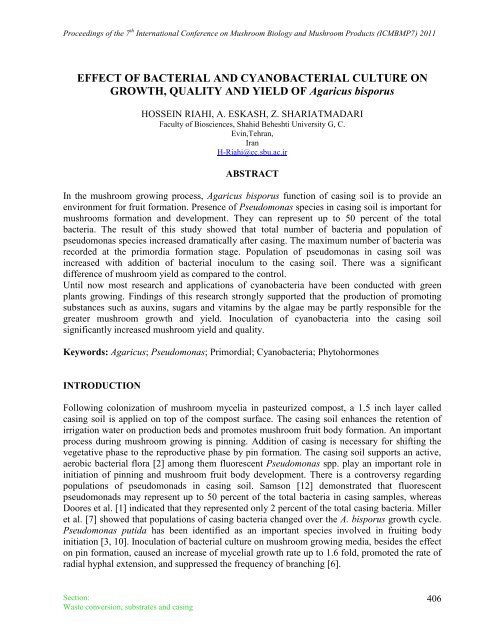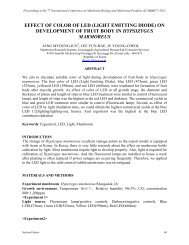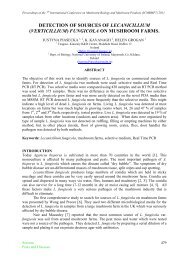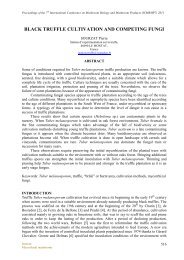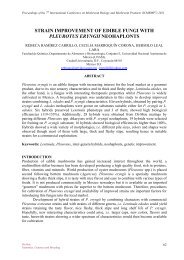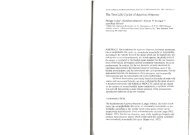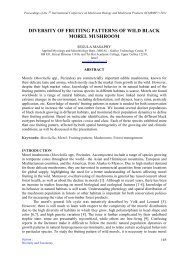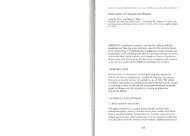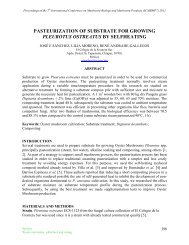Effect of bacterial and cyanobacterial culture on growth, quality and ...
Effect of bacterial and cyanobacterial culture on growth, quality and ...
Effect of bacterial and cyanobacterial culture on growth, quality and ...
You also want an ePaper? Increase the reach of your titles
YUMPU automatically turns print PDFs into web optimized ePapers that Google loves.
Proceedings <str<strong>on</strong>g>of</str<strong>on</strong>g> the 7 th Internati<strong>on</strong>al C<strong>on</strong>ference <strong>on</strong> Mushroom Biology <str<strong>on</strong>g>and</str<strong>on</strong>g> Mushroom Products (ICMBMP7) 2011<br />
EFFECT OF BACTERIAL AND CYANOBACTERIAL CULTURE ON<br />
GROWTH, QUALITY AND YIELD OF Agaricus bisporus<br />
HOSSEIN RIAHI, A. ESKASH, Z. SHARIATMADARI<br />
Faculty <str<strong>on</strong>g>of</str<strong>on</strong>g> Biosciences, Shahid Beheshti University G, C.<br />
Evin,Tehran,<br />
Iran<br />
H-Riahi@cc.sbu.ac.ir<br />
ABSTRACT<br />
In the mushroom growing process, Agaricus bisporus functi<strong>on</strong> <str<strong>on</strong>g>of</str<strong>on</strong>g> casing soil is to provide an<br />
envir<strong>on</strong>ment for fruit formati<strong>on</strong>. Presence <str<strong>on</strong>g>of</str<strong>on</strong>g> Pseudom<strong>on</strong>as species in casing soil is important for<br />
mushrooms formati<strong>on</strong> <str<strong>on</strong>g>and</str<strong>on</strong>g> development. They can represent up to 50 percent <str<strong>on</strong>g>of</str<strong>on</strong>g> the total<br />
bacteria. The result <str<strong>on</strong>g>of</str<strong>on</strong>g> this study showed that total number <str<strong>on</strong>g>of</str<strong>on</strong>g> bacteria <str<strong>on</strong>g>and</str<strong>on</strong>g> populati<strong>on</strong> <str<strong>on</strong>g>of</str<strong>on</strong>g><br />
pseudom<strong>on</strong>as species increased dramatically after casing. The maximum number <str<strong>on</strong>g>of</str<strong>on</strong>g> bacteria was<br />
recorded at the primordia formati<strong>on</strong> stage. Populati<strong>on</strong> <str<strong>on</strong>g>of</str<strong>on</strong>g> pseudom<strong>on</strong>as in casing soil was<br />
increased with additi<strong>on</strong> <str<strong>on</strong>g>of</str<strong>on</strong>g> <str<strong>on</strong>g>bacterial</str<strong>on</strong>g> inoculum to the casing soil. There was a significant<br />
difference <str<strong>on</strong>g>of</str<strong>on</strong>g> mushroom yield as compared to the c<strong>on</strong>trol.<br />
Until now most research <str<strong>on</strong>g>and</str<strong>on</strong>g> applicati<strong>on</strong>s <str<strong>on</strong>g>of</str<strong>on</strong>g> cyanobacteria have been c<strong>on</strong>ducted with green<br />
plants growing. Findings <str<strong>on</strong>g>of</str<strong>on</strong>g> this research str<strong>on</strong>gly supported that the producti<strong>on</strong> <str<strong>on</strong>g>of</str<strong>on</strong>g> promoting<br />
substances such as auxins, sugars <str<strong>on</strong>g>and</str<strong>on</strong>g> vitamins by the algae may be partly resp<strong>on</strong>sible for the<br />
greater mushroom <strong>growth</strong> <str<strong>on</strong>g>and</str<strong>on</strong>g> yield. Inoculati<strong>on</strong> <str<strong>on</strong>g>of</str<strong>on</strong>g> cyanobacteria into the casing soil<br />
significantly increased mushroom yield <str<strong>on</strong>g>and</str<strong>on</strong>g> <strong>quality</strong>.<br />
Keywords: Agaricus; Pseudom<strong>on</strong>as; Primordial; Cyanobacteria; Phytohorm<strong>on</strong>es<br />
INTRODUCTION<br />
Following col<strong>on</strong>izati<strong>on</strong> <str<strong>on</strong>g>of</str<strong>on</strong>g> mushroom mycelia in pasteurized compost, a 1.5 inch layer called<br />
casing soil is applied <strong>on</strong> top <str<strong>on</strong>g>of</str<strong>on</strong>g> the compost surface. The casing soil enhances the retenti<strong>on</strong> <str<strong>on</strong>g>of</str<strong>on</strong>g><br />
irrigati<strong>on</strong> water <strong>on</strong> producti<strong>on</strong> beds <str<strong>on</strong>g>and</str<strong>on</strong>g> promotes mushroom fruit body formati<strong>on</strong>. An important<br />
process during mushroom growing is pinning. Additi<strong>on</strong> <str<strong>on</strong>g>of</str<strong>on</strong>g> casing is necessary for shifting the<br />
vegetative phase to the reproductive phase by pin formati<strong>on</strong>. The casing soil supports an active,<br />
aerobic <str<strong>on</strong>g>bacterial</str<strong>on</strong>g> flora [2] am<strong>on</strong>g them fluorescent Pseudom<strong>on</strong>as spp. play an important role in<br />
initiati<strong>on</strong> <str<strong>on</strong>g>of</str<strong>on</strong>g> pinning <str<strong>on</strong>g>and</str<strong>on</strong>g> mushroom fruit body development. There is a c<strong>on</strong>troversy regarding<br />
populati<strong>on</strong>s <str<strong>on</strong>g>of</str<strong>on</strong>g> pseudom<strong>on</strong>ads in casing soil. Sams<strong>on</strong> [12] dem<strong>on</strong>strated that fluorescent<br />
pseudom<strong>on</strong>ads may represent up to 50 percent <str<strong>on</strong>g>of</str<strong>on</strong>g> the total bacteria in casing samples, whereas<br />
Doores et al. [1] indicated that they represented <strong>on</strong>ly 2 percent <str<strong>on</strong>g>of</str<strong>on</strong>g> the total casing bacteria. Miller<br />
et al. [7] showed that populati<strong>on</strong>s <str<strong>on</strong>g>of</str<strong>on</strong>g> casing bacteria changed over the A. bisporus <strong>growth</strong> cycle.<br />
Pseudom<strong>on</strong>as putida has been identified as an important species involved in fruiting body<br />
initiati<strong>on</strong> [3, 10]. Inoculati<strong>on</strong> <str<strong>on</strong>g>of</str<strong>on</strong>g> <str<strong>on</strong>g>bacterial</str<strong>on</strong>g> <str<strong>on</strong>g>culture</str<strong>on</strong>g> <strong>on</strong> mushroom growing media, besides the effect<br />
<strong>on</strong> pin formati<strong>on</strong>, caused an increase <str<strong>on</strong>g>of</str<strong>on</strong>g> mycelial <strong>growth</strong> rate up to 1.6 fold, promoted the rate <str<strong>on</strong>g>of</str<strong>on</strong>g><br />
radial hyphal extensi<strong>on</strong>, <str<strong>on</strong>g>and</str<strong>on</strong>g> suppressed the frequency <str<strong>on</strong>g>of</str<strong>on</strong>g> branching [6].<br />
Secti<strong>on</strong>:<br />
Waste c<strong>on</strong>versi<strong>on</strong>, substrates <str<strong>on</strong>g>and</str<strong>on</strong>g> casing<br />
406
Proceedings <str<strong>on</strong>g>of</str<strong>on</strong>g> the 7 th Internati<strong>on</strong>al C<strong>on</strong>ference <strong>on</strong> Mushroom Biology <str<strong>on</strong>g>and</str<strong>on</strong>g> Mushroom Products (ICMBMP7) 2011<br />
Soil is a habitat <str<strong>on</strong>g>of</str<strong>on</strong>g> some terrestrial blue-green algal species that are beneficial organisms for<br />
soil fertility by fixing atmospheric nitrogen, binding soil particles, helping to maintain moisture<br />
<str<strong>on</strong>g>and</str<strong>on</strong>g> preventing erosi<strong>on</strong>. These bacteria supply substances that promote the <strong>growth</strong> <str<strong>on</strong>g>of</str<strong>on</strong>g> plants.<br />
There are many reports that cyanobacteria produce phytohorm<strong>on</strong>es such as cytokinin, auxin <str<strong>on</strong>g>and</str<strong>on</strong>g><br />
auxin-like substances in soil [5, 13, 14, 15, 16]. Other plant <strong>growth</strong> regulator (PGR) substances<br />
such as amino acids, sugars, vitamins that may have a positive influence <strong>on</strong> <strong>growth</strong> <str<strong>on</strong>g>of</str<strong>on</strong>g> vascular<br />
plant are produced by cyanobacteria [5, 8, 9]. Until now most research <str<strong>on</strong>g>and</str<strong>on</strong>g> applicati<strong>on</strong>s <str<strong>on</strong>g>of</str<strong>on</strong>g><br />
cyanobacteria have been c<strong>on</strong>ducted with green plants. This is a first attempt to study the effect <str<strong>on</strong>g>of</str<strong>on</strong>g><br />
cyanobacteria <strong>on</strong> mushroom. Moreover, cyanobacteria may enhance producti<strong>on</strong> <str<strong>on</strong>g>of</str<strong>on</strong>g> sec<strong>on</strong>dary<br />
metabolites. These phenomena may be c<strong>on</strong>trolled with or mediated by horm<strong>on</strong>es [11, 13].<br />
Cyanobacteria are another group <str<strong>on</strong>g>of</str<strong>on</strong>g> microorganisms that might have a positive effect <strong>on</strong><br />
mushroom yield.<br />
MATERIALS AND METHODS<br />
In this work two experiments were c<strong>on</strong>ducted. The first study c<strong>on</strong>cerned the <str<strong>on</strong>g>bacterial</str<strong>on</strong>g> populati<strong>on</strong><br />
in casing soil <str<strong>on</strong>g>and</str<strong>on</strong>g> effects <str<strong>on</strong>g>of</str<strong>on</strong>g> Pseudom<strong>on</strong>as patuda used as <str<strong>on</strong>g>bacterial</str<strong>on</strong>g> inoculum, <strong>on</strong> yield <str<strong>on</strong>g>and</str<strong>on</strong>g><br />
<strong>quality</strong> <str<strong>on</strong>g>of</str<strong>on</strong>g> mushroom. A similar objective was followed in the sec<strong>on</strong>d trial but algal <str<strong>on</strong>g>culture</str<strong>on</strong>g> was<br />
used for inoculati<strong>on</strong>.<br />
Experiment 1. Isolati<strong>on</strong> <str<strong>on</strong>g>and</str<strong>on</strong>g> cultivati<strong>on</strong> <str<strong>on</strong>g>of</str<strong>on</strong>g> Pseudom<strong>on</strong>as species from casing soil. After<br />
col<strong>on</strong>izati<strong>on</strong> <str<strong>on</strong>g>of</str<strong>on</strong>g> compost with mushroom mycelium, the substrate was covered with casing soil.<br />
Sampling was carried out in Malard mushroom research farm. To determine Pseudom<strong>on</strong>as<br />
populati<strong>on</strong>, casing soil was sampled periodically until primordia formati<strong>on</strong>. Specified amount <str<strong>on</strong>g>of</str<strong>on</strong>g><br />
the diluti<strong>on</strong>s transferred <strong>on</strong> to sterile plates <str<strong>on</strong>g>of</str<strong>on</strong>g> nutrient agar (NA) <str<strong>on</strong>g>and</str<strong>on</strong>g> Chromagar Pseudom<strong>on</strong>as<br />
(PS822) media. Inoculated plates were incubated at 30 o C for 24h. Col<strong>on</strong>ies that appeared at the<br />
end <str<strong>on</strong>g>of</str<strong>on</strong>g> incubati<strong>on</strong> were counted, the unit expressed in terms <str<strong>on</strong>g>of</str<strong>on</strong>g> col<strong>on</strong>y-forming units per gram<br />
(CFU/g) <str<strong>on</strong>g>of</str<strong>on</strong>g> original sample. The isolates were further subjected to st<str<strong>on</strong>g>and</str<strong>on</strong>g>ard biochemical tests.<br />
Bacterial identificati<strong>on</strong> <str<strong>on</strong>g>of</str<strong>on</strong>g> isolates was carried out by comparing the results obtained with<br />
Bergey’s Manual <str<strong>on</strong>g>of</str<strong>on</strong>g> Determinative Systematic Bacteriology. The predominant Pseudom<strong>on</strong>as<br />
species isolated from casing soil was tested to study the <strong>growth</strong> <str<strong>on</strong>g>of</str<strong>on</strong>g> mycelium <str<strong>on</strong>g>and</str<strong>on</strong>g> pin formati<strong>on</strong>.<br />
Inocula were prepared by growing the selective strains in nutrient broth (NB) medium.<br />
After incubati<strong>on</strong> at 30 o C for 18h, the densities <str<strong>on</strong>g>of</str<strong>on</strong>g> <str<strong>on</strong>g>culture</str<strong>on</strong>g> were determined at OD600. Then<br />
<str<strong>on</strong>g>culture</str<strong>on</strong>g>s were diluted further in serum until final <str<strong>on</strong>g>bacterial</str<strong>on</strong>g> cell numbers were 10 8 cells/ml.<br />
Bacterial suspensi<strong>on</strong>s (5 L) were sprayed <strong>on</strong> 42 m 2 <str<strong>on</strong>g>of</str<strong>on</strong>g> casing soil at time <str<strong>on</strong>g>of</str<strong>on</strong>g> casing.<br />
Protein c<strong>on</strong>tents <str<strong>on</strong>g>of</str<strong>on</strong>g> fruit bodies were calculated from the nitrogen c<strong>on</strong>tent (N×6.25) as<br />
determined by micro-Kjeldahl method [4].<br />
Experiment 2. Cyanobacteria cultivati<strong>on</strong>. Am<strong>on</strong>g the cyanobacteria isolated from different<br />
paddy fields <strong>on</strong>e heterocyestous cyanobacteria (Nostoc) was selected because it showed a high<br />
<strong>growth</strong> rate. Isolates were grown in BG11 nitrogen free medium in a 2 L c<strong>on</strong>tainer at 24°C <str<strong>on</strong>g>and</str<strong>on</strong>g> a<br />
12/12 h light/dark cycle with artificial illuminati<strong>on</strong> (2000-2500 Luxes) <str<strong>on</strong>g>and</str<strong>on</strong>g> c<strong>on</strong>stant stirring <str<strong>on</strong>g>and</str<strong>on</strong>g><br />
aerati<strong>on</strong>. After three weeks, the <str<strong>on</strong>g>culture</str<strong>on</strong>g> was harvested <str<strong>on</strong>g>and</str<strong>on</strong>g> used as inoculum. Additi<strong>on</strong> <str<strong>on</strong>g>of</str<strong>on</strong>g> algal<br />
<str<strong>on</strong>g>culture</str<strong>on</strong>g> was carried out at the primordia formati<strong>on</strong> stage, before sec<strong>on</strong>d <str<strong>on</strong>g>and</str<strong>on</strong>g> third flushes.<br />
Secti<strong>on</strong>:<br />
Waste c<strong>on</strong>versi<strong>on</strong>, substrates <str<strong>on</strong>g>and</str<strong>on</strong>g> casing<br />
407
Proceedings <str<strong>on</strong>g>of</str<strong>on</strong>g> the 7 th Internati<strong>on</strong>al C<strong>on</strong>ference <strong>on</strong> Mushroom Biology <str<strong>on</strong>g>and</str<strong>on</strong>g> Mushroom Products (ICMBMP7) 2011<br />
Mushroom producti<strong>on</strong>. The compost formulati<strong>on</strong> c<strong>on</strong>sisted <str<strong>on</strong>g>of</str<strong>on</strong>g> wheat straw, chicken manure<br />
<str<strong>on</strong>g>and</str<strong>on</strong>g> gypsum prepared in c<strong>on</strong>venti<strong>on</strong>al yard <str<strong>on</strong>g>and</str<strong>on</strong>g> pasteurizati<strong>on</strong> tunnels. Mushrooms were grown<br />
in c<strong>on</strong>trolled <str<strong>on</strong>g>and</str<strong>on</strong>g> st<str<strong>on</strong>g>and</str<strong>on</strong>g>ard growing room. After col<strong>on</strong>izati<strong>on</strong> <str<strong>on</strong>g>of</str<strong>on</strong>g> compost with A. bisporus<br />
(commercial strain Sylvan A15) mycelium, the substrate was covered with 4-5 cm <str<strong>on</strong>g>of</str<strong>on</strong>g> casing soil.<br />
Mushroom yield was determined over a 3-weeks producti<strong>on</strong> period. Mushrooms were weighted<br />
after removal <str<strong>on</strong>g>of</str<strong>on</strong>g> stipes.<br />
Statistical analysis. Data were subjected to analysis <str<strong>on</strong>g>of</str<strong>on</strong>g> variance (ANOVA) <str<strong>on</strong>g>and</str<strong>on</strong>g> means were<br />
compared using LSD test (P
Proceedings <str<strong>on</strong>g>of</str<strong>on</strong>g> the 7 th Internati<strong>on</strong>al C<strong>on</strong>ference <strong>on</strong> Mushroom Biology <str<strong>on</strong>g>and</str<strong>on</strong>g> Mushroom Products (ICMBMP7) 2011<br />
percent in the third break. Protein c<strong>on</strong>tent <str<strong>on</strong>g>of</str<strong>on</strong>g> treated mushrooms also increased with 3 to 5<br />
percent in three breaks compared to untreated mushrooms (Table 1).<br />
Table 1. <str<strong>on</strong>g>Effect</str<strong>on</strong>g> <str<strong>on</strong>g>of</str<strong>on</strong>g> <str<strong>on</strong>g>bacterial</str<strong>on</strong>g> <str<strong>on</strong>g>culture</str<strong>on</strong>g> <strong>on</strong> yield, dry matter <str<strong>on</strong>g>and</str<strong>on</strong>g> protein c<strong>on</strong>tent <str<strong>on</strong>g>of</str<strong>on</strong>g> mushroom<br />
First picking Sec<strong>on</strong>d picking Third picking<br />
Sample<br />
Yield D.M Protein<br />
Kg/m 2 % %<br />
Yield D.M Protein<br />
Kg/m 2 % %<br />
Yield D.M Protein<br />
Kg/m 2 % %<br />
C<strong>on</strong>trol 11.8 8.2 37 7.9 7.9 34 4.8 7.5 32<br />
Test 12.1 ns 8.7 * 40* 10 ** 8.5 * * 4.4 ns 8.2 * *<br />
39 **<br />
37 **<br />
Diff. 0.3 0.5 3.0 2.1 0.6 5.0 - 0.4 0.7 5.0<br />
* * s i g n i f i c a n c e < 1 % l e v e l , * s i g n i f i c a n c e < 5 % l e v e l , n s :<br />
n o t s i g n i f i c a n t<br />
Casing soil was irrigated with algal <str<strong>on</strong>g>culture</str<strong>on</strong>g> at the primordia formati<strong>on</strong> stage, before<br />
sec<strong>on</strong>d <str<strong>on</strong>g>and</str<strong>on</strong>g> third breaks. There was a significant difference in mushroom yield in three flushes<br />
treated with cyano<str<strong>on</strong>g>bacterial</str<strong>on</strong>g> <str<strong>on</strong>g>culture</str<strong>on</strong>g> as compared to the c<strong>on</strong>trol. Mushroom yield was increased<br />
0.661 kg/m 2 in first, 2.2 kg/m 2 in sec<strong>on</strong>d flush <str<strong>on</strong>g>and</str<strong>on</strong>g> 0.053 kg/m 2 in the third flush as compared to<br />
the c<strong>on</strong>trol. The result also showed that inoculati<strong>on</strong> <str<strong>on</strong>g>of</str<strong>on</strong>g> casing soil with cyanobacteria had a<br />
positive effect <strong>on</strong> <strong>quality</strong> <str<strong>on</strong>g>of</str<strong>on</strong>g> mushroom. Dry matter c<strong>on</strong>tent <str<strong>on</strong>g>of</str<strong>on</strong>g> mushrooms increased in the first<br />
flush. Dry matter was measured at 9.75 % in treated <str<strong>on</strong>g>and</str<strong>on</strong>g> 8.35 % in untreated mushroom.<br />
However, the amount <str<strong>on</strong>g>of</str<strong>on</strong>g> dry matter <str<strong>on</strong>g>and</str<strong>on</strong>g> protein declined in sec<strong>on</strong>d <str<strong>on</strong>g>and</str<strong>on</strong>g> third flush as compared to<br />
the first flush. There was a slight difference in dry matter in treated <str<strong>on</strong>g>and</str<strong>on</strong>g> untreated mushroom in<br />
sec<strong>on</strong>d <str<strong>on</strong>g>and</str<strong>on</strong>g> third flushes. Additi<strong>on</strong> <str<strong>on</strong>g>of</str<strong>on</strong>g> algal <str<strong>on</strong>g>culture</str<strong>on</strong>g> had a positive effect <strong>on</strong> protein c<strong>on</strong>tent <str<strong>on</strong>g>of</str<strong>on</strong>g><br />
mushroom. The amount protein was increased significantly in first flush, but there was a slight<br />
difference between treated <str<strong>on</strong>g>and</str<strong>on</strong>g> c<strong>on</strong>trol in sec<strong>on</strong>d flush. Whereas, in the third flush protein<br />
c<strong>on</strong>tent <str<strong>on</strong>g>of</str<strong>on</strong>g> treated mushroom was less than c<strong>on</strong>trol (Table 2).<br />
Table 2. <str<strong>on</strong>g>Effect</str<strong>on</strong>g> <str<strong>on</strong>g>of</str<strong>on</strong>g> algal <str<strong>on</strong>g>culture</str<strong>on</strong>g> <strong>on</strong> yield, dry matter <str<strong>on</strong>g>and</str<strong>on</strong>g> protein c<strong>on</strong>tent <str<strong>on</strong>g>of</str<strong>on</strong>g> mushroom<br />
Sample First Flush Sec<strong>on</strong>d Flush Third Flush<br />
Yield D.M Protein<br />
Kg/m 2 % %<br />
Yield D.M Protein<br />
Kg/m 2 % %<br />
Yield D.M Protein<br />
Kg/m 2 % %<br />
C<strong>on</strong>trol 12.59 8.35 48.1 7.58 8.3 45.1 2.75 7.40 41.1<br />
Test 13.2 * 9.75 * *<br />
51.9 **<br />
9.78 ** 8.6 *<br />
45.5 ns<br />
2.80 ns 7.50 ns<br />
39.1 ns<br />
Diff. 0.61 1.4 3.8 2.2 0.3 0.4 0.05 0.10 -2.0<br />
* * s i g n i f i c a n c e < 1 % l e v e l , * s i g n i f i c a n c e < 5 % l e v e l ,<br />
n s : n o t s i g n i f i c a n t<br />
Secti<strong>on</strong>:<br />
Waste c<strong>on</strong>versi<strong>on</strong>, substrates <str<strong>on</strong>g>and</str<strong>on</strong>g> casing<br />
409
Proceedings <str<strong>on</strong>g>of</str<strong>on</strong>g> the 7 th Internati<strong>on</strong>al C<strong>on</strong>ference <strong>on</strong> Mushroom Biology <str<strong>on</strong>g>and</str<strong>on</strong>g> Mushroom Products (ICMBMP7) 2011<br />
CONCLUSION<br />
In cultivati<strong>on</strong> <str<strong>on</strong>g>of</str<strong>on</strong>g> A. bisporus, compost <str<strong>on</strong>g>and</str<strong>on</strong>g> casing soil are two major elements. Studies<br />
have dem<strong>on</strong>strated that populati<strong>on</strong>s <str<strong>on</strong>g>of</str<strong>on</strong>g> pseudom<strong>on</strong>as in the casing layer <strong>on</strong> which the mushroom<br />
fruit body develops is very important. In most <str<strong>on</strong>g>of</str<strong>on</strong>g> the studies, total <str<strong>on</strong>g>bacterial</str<strong>on</strong>g> populati<strong>on</strong>s ranged<br />
from 8.0 to 8.5 log CFU/g casing material. With a slight difference, this result is same as other<br />
workers. The majority <str<strong>on</strong>g>of</str<strong>on</strong>g> <str<strong>on</strong>g>bacterial</str<strong>on</strong>g> populati<strong>on</strong> in casing was attributed to pseudom<strong>on</strong>as species.<br />
In this study they present more than 80 present <str<strong>on</strong>g>of</str<strong>on</strong>g> the <str<strong>on</strong>g>bacterial</str<strong>on</strong>g> populati<strong>on</strong> in the casing layer.<br />
The result showed that there is a close relati<strong>on</strong> between <strong>growth</strong> <str<strong>on</strong>g>of</str<strong>on</strong>g> mycelium <str<strong>on</strong>g>and</str<strong>on</strong>g> number <str<strong>on</strong>g>of</str<strong>on</strong>g><br />
bacteria in casing soil. Sampling <str<strong>on</strong>g>of</str<strong>on</strong>g> casing soil at different periods <str<strong>on</strong>g>of</str<strong>on</strong>g> mushroom growing cycle<br />
revealed that number <str<strong>on</strong>g>of</str<strong>on</strong>g> bacteria increased simultaneously with increase <strong>growth</strong> <str<strong>on</strong>g>of</str<strong>on</strong>g> mycelium<br />
into casing soil. At the pining stage, populati<strong>on</strong>s <str<strong>on</strong>g>of</str<strong>on</strong>g> pseudom<strong>on</strong>as species especially P. putida<br />
were important since they are playing a key role in fruiting body formati<strong>on</strong>. We c<strong>on</strong>clude that<br />
inoculati<strong>on</strong> <str<strong>on</strong>g>of</str<strong>on</strong>g> native P. putida isolated from casing soil at the primordia formati<strong>on</strong> stage will be<br />
very efficient for increasing mushroom yield <str<strong>on</strong>g>and</str<strong>on</strong>g> <strong>quality</strong>.<br />
In the sec<strong>on</strong>d experiment the applicati<strong>on</strong> <str<strong>on</strong>g>of</str<strong>on</strong>g> cyano<str<strong>on</strong>g>bacterial</str<strong>on</strong>g> <str<strong>on</strong>g>culture</str<strong>on</strong>g> <strong>on</strong> casing soil <str<strong>on</strong>g>and</str<strong>on</strong>g> its effect <strong>on</strong><br />
mushroom yield <str<strong>on</strong>g>and</str<strong>on</strong>g> <strong>quality</strong> was investigated. Irrigati<strong>on</strong> <str<strong>on</strong>g>of</str<strong>on</strong>g> casing soil with cyano<str<strong>on</strong>g>bacterial</str<strong>on</strong>g><br />
<str<strong>on</strong>g>culture</str<strong>on</strong>g> increased yield, dry matter <str<strong>on</strong>g>and</str<strong>on</strong>g> protein c<strong>on</strong>tent <str<strong>on</strong>g>of</str<strong>on</strong>g> mushrooms. Producti<strong>on</strong> <str<strong>on</strong>g>of</str<strong>on</strong>g> promoting<br />
substances such as auxins, sugars <str<strong>on</strong>g>and</str<strong>on</strong>g> vitamins by the algae are the main factors for this issue.<br />
ACKNOWLEDGEMENTS<br />
We are very much thankful to the managers <str<strong>on</strong>g>and</str<strong>on</strong>g> staff <str<strong>on</strong>g>of</str<strong>on</strong>g> Malard mushroom company –<br />
especially Mr. Kabei, Judy, Soltan Shah, Marzoughi <str<strong>on</strong>g>and</str<strong>on</strong>g> Ebrahimi for their assessment. Without<br />
their help we would not be able to carry out this research. The authors are also grateful to the<br />
University <str<strong>on</strong>g>of</str<strong>on</strong>g> Shahid Beheshti for financial support.<br />
REFERENCES<br />
[1] Doores S., Kramer M., Beelman R. (1986). Evaluati<strong>on</strong> <str<strong>on</strong>g>and</str<strong>on</strong>g> <str<strong>on</strong>g>bacterial</str<strong>on</strong>g> populati<strong>on</strong>s associated<br />
with fresh mushrooms (Agaricus bisporus), in Developments. In: Proceedings <str<strong>on</strong>g>of</str<strong>on</strong>g> Intl. Symp.<br />
Scientific. Technical. Aspects <str<strong>on</strong>g>of</str<strong>on</strong>g> Cultivating Edible Fungi. Wuest P.J., Royse D.J. &<br />
Beelman R.B. Eds. 10, 283-294.<br />
[2] Hayes WA., Nair NG. (1976). <str<strong>on</strong>g>Effect</str<strong>on</strong>g>s <str<strong>on</strong>g>of</str<strong>on</strong>g> volatile metabolic by-products <str<strong>on</strong>g>of</str<strong>on</strong>g> mushroom<br />
mycelium <strong>on</strong> the ecology <str<strong>on</strong>g>of</str<strong>on</strong>g> the casing layer. Mushroom Science. IX: 259-268.<br />
[3] Hayes WA., R<str<strong>on</strong>g>and</str<strong>on</strong>g>le PE.,Last FT. (1969). The nature <str<strong>on</strong>g>of</str<strong>on</strong>g> the microbial stimulus affecting<br />
sporophore formati<strong>on</strong> in Agaricus bisporus (Lange) Sing. Ann. Appl. Biol. 64: 177-187.<br />
[4] Jacks<strong>on</strong> ML. (1973). Total nitrogen was estimated by the micro Kjeldahl digesti<strong>on</strong> method.<br />
Soil Chemical Analysis. Prentice Hall <str<strong>on</strong>g>of</str<strong>on</strong>g> India Pvt. Ltd, New Delhi.<br />
[5] Karthikeyan N., et al. (2007). Evaluating the potential <str<strong>on</strong>g>of</str<strong>on</strong>g> plant <strong>growth</strong> promoting<br />
cyanobacteria as inoculants for wheat. Eur. J. Soil Biol. 43(1): 23-30.<br />
[6] Kim MK., Math RK, Cho KM., Shin KJ., Kim JO.,Ryu JS., Lee YH. &Yun HD. (2008).<br />
<str<strong>on</strong>g>Effect</str<strong>on</strong>g> <str<strong>on</strong>g>of</str<strong>on</strong>g> Psudom<strong>on</strong>as sp. P7014 <strong>on</strong> the <strong>growth</strong> <str<strong>on</strong>g>of</str<strong>on</strong>g> edible mushroom Pleurotus eryngii in<br />
bottle <str<strong>on</strong>g>culture</str<strong>on</strong>g> for commercial producti<strong>on</strong>. Bioresource Technol. 99: 3306-3308.<br />
Secti<strong>on</strong>:<br />
Waste c<strong>on</strong>versi<strong>on</strong>, substrates <str<strong>on</strong>g>and</str<strong>on</strong>g> casing<br />
410
Proceedings <str<strong>on</strong>g>of</str<strong>on</strong>g> the 7 th Internati<strong>on</strong>al C<strong>on</strong>ference <strong>on</strong> Mushroom Biology <str<strong>on</strong>g>and</str<strong>on</strong>g> Mushroom Products (ICMBMP7) 2011<br />
[7] Miller N., Gillespie JB., Doyle OPE. (1995). The involvement <str<strong>on</strong>g>of</str<strong>on</strong>g> microbiological<br />
comp<strong>on</strong>ents <str<strong>on</strong>g>of</str<strong>on</strong>g> peat based casing materials in fructificati<strong>on</strong> <str<strong>on</strong>g>of</str<strong>on</strong>g> Agaricus bisporus. Mushroom<br />
Sci. 14(1): 313-321.<br />
[8] Misra S., Kaushik B.D. (1989a). Growth promoting substances <str<strong>on</strong>g>of</str<strong>on</strong>g> cyanobacteria. Vitamins<br />
<str<strong>on</strong>g>and</str<strong>on</strong>g> their influence <strong>on</strong> rice plant. Proc. Indian Sci. Acad. B55: 295-300.<br />
[9] Misra S., Kaushik B.D. (1989b). Growth promoting substances <str<strong>on</strong>g>of</str<strong>on</strong>g> cyanobacteria II.<br />
Detecti<strong>on</strong> <str<strong>on</strong>g>of</str<strong>on</strong>g> amino acids, sugars <str<strong>on</strong>g>and</str<strong>on</strong>g> auxins. Proc. Indian Sci. Acad. B55:499-504.<br />
[10] Rainey PB., et al. (1990). A model system for examining involvement <str<strong>on</strong>g>of</str<strong>on</strong>g> bacteria in<br />
basidiome initiati<strong>on</strong> <str<strong>on</strong>g>of</str<strong>on</strong>g> Agaricus bisporus. Mycol. Res. 94: 191-195.<br />
[11] Saker M., Shanab S., Khater M. (2000). In vitro studies <strong>on</strong> Ambrosia maritime. I-<br />
Morphogenic resp<strong>on</strong>ses <str<strong>on</strong>g>and</str<strong>on</strong>g> algal toxins elicitati<strong>on</strong>. Arab J. Biotech. 3(2): 217-224.<br />
[12] Sams<strong>on</strong> R. (1986). Variability <str<strong>on</strong>g>of</str<strong>on</strong>g> fluorescent Pseudom<strong>on</strong>as populati<strong>on</strong>s in composts <str<strong>on</strong>g>and</str<strong>on</strong>g><br />
casing soils used for mushroom <str<strong>on</strong>g>culture</str<strong>on</strong>g>s. In: Proceedings <str<strong>on</strong>g>of</str<strong>on</strong>g> Intl. Symp. Scientific. Technical.<br />
Aspects <str<strong>on</strong>g>of</str<strong>on</strong>g> Cultivating Edible Fungi. Wuest P.J., Royse D.J. & Beelman R.B. Eds. 10, 19-25.<br />
[13] Shanab S. (2001). <str<strong>on</strong>g>Effect</str<strong>on</strong>g> <str<strong>on</strong>g>of</str<strong>on</strong>g> fresh water cyano<str<strong>on</strong>g>bacterial</str<strong>on</strong>g> extracts <strong>on</strong> alkaloid producti<strong>on</strong> <str<strong>on</strong>g>of</str<strong>on</strong>g><br />
the in vitro Solanum elaeagnifolium tissue <str<strong>on</strong>g>culture</str<strong>on</strong>g>. Arab J. Biotech. 4(1): 129-140.<br />
[14] Stirk MA., Ördog V., Van Staden J & Jäger K. (2002). Cytokinin <str<strong>on</strong>g>and</str<strong>on</strong>g> auxin-like activity in<br />
Cyanophyta <str<strong>on</strong>g>and</str<strong>on</strong>g> microalgae. J. Appl. Phycol. 14: 215-221.<br />
[15] Tarakhovskaya ER., Maslov YI. & Shishova MF. (2007). Phytohorm<strong>on</strong>es in algae. Russ J.<br />
Plant Physiol. 54(2):186-194.<br />
[16] Whitt<strong>on</strong> BA. (2000). Soil <str<strong>on</strong>g>and</str<strong>on</strong>g> rice-fields. In: Whitt<strong>on</strong> B.A. <str<strong>on</strong>g>and</str<strong>on</strong>g> Potts M. (eds), The Ecology<br />
<str<strong>on</strong>g>of</str<strong>on</strong>g> Cyanobacteria. Kluwer Academic Publishers, Dordrecht, pp. 233-255.<br />
[17] Wood DA. (1976). Primordium formati<strong>on</strong> in axenic <str<strong>on</strong>g>culture</str<strong>on</strong>g>s <str<strong>on</strong>g>of</str<strong>on</strong>g> Agaricus bisporus (Lange)<br />
Sing. J. Gen. Microbiol. 95: 313-323.<br />
Secti<strong>on</strong>:<br />
Waste c<strong>on</strong>versi<strong>on</strong>, substrates <str<strong>on</strong>g>and</str<strong>on</strong>g> casing<br />
411


